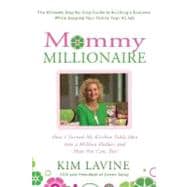
Note: Supplemental materials are not guaranteed with Rental or Used book purchases.
Purchase Benefits
Looking to rent a book? Rent Mommy Millionaire How I Turned My Kitchen Table Idea into a Million Dollars and How You Can, Too! [ISBN: 9780312354718] for the semester, quarter, and short term or search our site for other textbooks by Lavine, Kim. Renting a textbook can save you up to 90% from the cost of buying.
| Acknowledgments | p. ix |
| Letter to the Reader | p. xi |
| Introduction | p. 1 |
| The IDEA: My Own Incredible Story | p. 11 |
| The Birth of a Business | p. 29 |
| The Business Entity | p. 72 |
| Launching, or Traveling Through the Valley of Shadow | p. 88 |
| Entrepreneurs-and Millionaires-Aren't Born; They're Made | p. 118 |
| You're Gonna Wuvit | p. 142 |
| How I Made $225,000 in Eight Weeks | p. 164 |
| The Scam Artists Who Stung Me and What I Learned | p. 179 |
| Behind the Scenes at QVC | p. 192 |
| Failing is Easy-Getting Up Again is What's Hard | p. 213 |
| Send Lawyers, Guns, and Money! What to do When Everything Goes Wrong | p. 230 |
| How the Worst Thing That Ever Happened to Me Turned Out to Be The Best Thing That Ever Happened to Me | p. 242 |
| Breaking Down the Doors of Big Retailers | p. 257 |
| Free Money: Working With Angel Investors and Venture Capitalists | p. 267 |
| The Importance of Attitude | p. 286 |
| Show Me the Money | p. 301 |
| The End of the Beginning | p. 320 |
| Become Your Own Mommy Millionaire: How To Become Part of the Millionaire Mentor Club | p. 331 |
| Afterword | p. 337 |
| Index | p. 339 |
| Table of Contents provided by Ingram. All Rights Reserved. |
The New copy of this book will include any supplemental materials advertised. Please check the title of the book to determine if it should include any access cards, study guides, lab manuals, CDs, etc.
The Used, Rental and eBook copies of this book are not guaranteed to include any supplemental materials. Typically, only the book itself is included. This is true even if the title states it includes any access cards, study guides, lab manuals, CDs, etc.
Excerpted from Mommy Millionaire: How I Turned My Kitchen Table Idea into a Million Dollars and How You Can, Too! by Kim Lavine
All rights reserved by the original copyright owners. Excerpts are provided for display purposes only and may not be reproduced, reprinted or distributed without the written permission of the publisher.